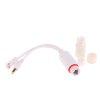Hello everyone.
I'm facing a challenge with the outdoor installation of some Dahua consumer Imou cameras, and I'm looking for advice or experiences you might share.
- The cameras come with a pigtail that includes an RJ45 Ethernet connector and a 12V barrel plug connector.
- They are also supplied with a standard indoor 12V AC adapter.
When mounting these cameras outdoors, the AC adapter needs to be placed indoors or within a large waterproof housing. Additionally, while the RJ45 connector has a waterproof cover, the barrel plug does not.

These cameras are obviously not in the same league as the professional Dahua cameras, but for cheap consumer cameras they are pretty good, with that being said I find this flaw to perhaps be their most limiting factor.
I would prefer to power these cameras via PoE. I've found some splitters on AliExpress and eBay that claim to split 48V PoE into a 12V barrel plug and RJ45, which should fit the camera's pigtail.
Example:

Anyone have experience with these and found a waterproof version for the 12V barrel plug?
Something like this perhaps:
I also stumbled upon some PCB boards that could fit inside the camera to swap out the original pigtail. But I haven't found anyone who's done this as a DIY PoE 'upgrade.' Maybe they’re just for replacing parts on cameras that already had them?

Would love to hear if anyone has tried something similar or has any pointers!
(I hope it's ok to post Imou related questions in the Dahua subforum)
Thanks!
I'm facing a challenge with the outdoor installation of some Dahua consumer Imou cameras, and I'm looking for advice or experiences you might share.
- The cameras come with a pigtail that includes an RJ45 Ethernet connector and a 12V barrel plug connector.
- They are also supplied with a standard indoor 12V AC adapter.
When mounting these cameras outdoors, the AC adapter needs to be placed indoors or within a large waterproof housing. Additionally, while the RJ45 connector has a waterproof cover, the barrel plug does not.

These cameras are obviously not in the same league as the professional Dahua cameras, but for cheap consumer cameras they are pretty good, with that being said I find this flaw to perhaps be their most limiting factor.
I would prefer to power these cameras via PoE. I've found some splitters on AliExpress and eBay that claim to split 48V PoE into a 12V barrel plug and RJ45, which should fit the camera's pigtail.
Example:

Anyone have experience with these and found a waterproof version for the 12V barrel plug?
Something like this perhaps:

I also stumbled upon some PCB boards that could fit inside the camera to swap out the original pigtail. But I haven't found anyone who's done this as a DIY PoE 'upgrade.' Maybe they’re just for replacing parts on cameras that already had them?

Would love to hear if anyone has tried something similar or has any pointers!
(I hope it's ok to post Imou related questions in the Dahua subforum)
Thanks!







